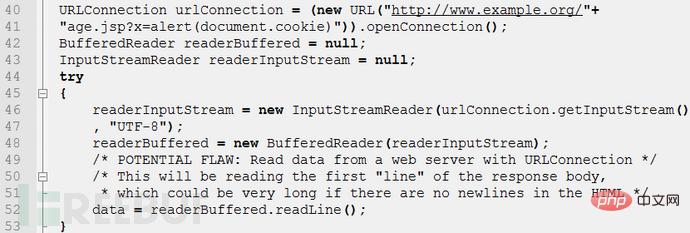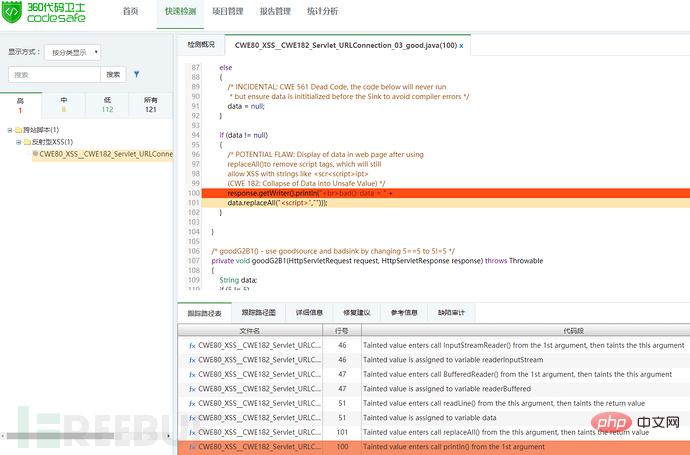How to analyze reflected XSS
1. Reflected XSS
Reflected XSS means that the application obtains untrustworthy data through Web requests, without checking whether the data contains malicious code. It is delivered to Web users. Reflected XSS is generally constructed by attackers with URLs containing malicious code parameters. When the URL address is opened, the unique malicious code parameters are parsed and executed by HTML. It is characterized by non-persistence and requires the user to click on a link with specific parameters. can cause. The editor takes the JAVA language source code as an example to analyze CWE ID 80: Improper Neutralization of Script-Related HTML Tags in a Web Page (Basic XSS)
2. The dangers of reflected XSS
When a user accesses a URL request with XSS code, the server receives the data and processes it, then sends the data with XSS code to the browser, and the browser parses the data with XSS code Finally, an XSS vulnerability is created, which may lead to stealing the cookies of the target website and transferring them to the attacker's server, reading the user's undisclosed information, or performing click hijacking to implement phishing attacks. From January to November 2018, there were a total of 126 vulnerability information related to it in CVE. Some of the vulnerabilities are as follows:
| Vulnerability Overview | |
|---|---|
| tianti is a free lightweight CMS system written in Java. It currently provides an overall solution from back-end management to front-end display. Among them, tianti 2.3 has a reflected XSS vulnerability in the user management module through the tianti-module-admin / user /list userName parameter. | |
| Matera Banco 1.0.0 is vulnerable to multiple reflected XSS, as shown in /contingency/web/index.jsp (aka Home page) url parameters. | |
| ZohoManageEngine Applications Manager provides solutions for monitoring and managing J2EE underlying structures and J2EE applications. A reflected cross-site scripting (XSS) vulnerability in Zoho ManageEngine Applications Manager 13 (Build13800) allows remote attackers to inject arbitrary web script or HTML via the 'method' parameter to GraphicalView.do. | |
| LAMS is a new generation of JAVA-based learning software jointly developed by Macquarie University in Australia, LAMS International Co., Ltd. and LAMS Foundation. . Unauthenticated reflected cross-site scripting (XSS) exists in LAMS before 3.1, allowing remote attackers in forgetPasswordChange.jsp? Introducing arbitrary JavaScript via manipulation of unspecified GET parameters during key = password change. |
The above is the detailed content of How to analyze reflected XSS. For more information, please follow other related articles on the PHP Chinese website!

Hot AI Tools

Undresser.AI Undress
AI-powered app for creating realistic nude photos

AI Clothes Remover
Online AI tool for removing clothes from photos.

Undress AI Tool
Undress images for free

Clothoff.io
AI clothes remover

AI Hentai Generator
Generate AI Hentai for free.

Hot Article

Hot Tools

Notepad++7.3.1
Easy-to-use and free code editor

SublimeText3 Chinese version
Chinese version, very easy to use

Zend Studio 13.0.1
Powerful PHP integrated development environment

Dreamweaver CS6
Visual web development tools

SublimeText3 Mac version
God-level code editing software (SublimeText3)

Hot Topics
 Cross-site scripting (XSS) and cross-site request forgery (CSRF) protection in Laravel
Aug 13, 2023 pm 04:43 PM
Cross-site scripting (XSS) and cross-site request forgery (CSRF) protection in Laravel
Aug 13, 2023 pm 04:43 PM
Cross-site scripting (XSS) and cross-site request forgery (CSRF) protection in Laravel With the development of the Internet, network security issues have become more and more serious. Among them, Cross-SiteScripting (XSS) and Cross-SiteRequestForgery (CSRF) are one of the most common attack methods. Laravel, as a popular PHP development framework, provides users with a variety of security mechanisms
 How to defend against XSS and remote code execution attacks in PHP
Jun 30, 2023 am 08:04 AM
How to defend against XSS and remote code execution attacks in PHP
Jun 30, 2023 am 08:04 AM
How to use PHP to defend against cross-site scripting (XSS) and remote code execution attacks Introduction: In today's Internet world, security has become a vital issue. XSS (cross-site scripting) and remote code execution attacks are two of the most common security vulnerabilities. This article will explore how to use the PHP language to defend against these two attacks and provide several methods and techniques to protect your website from these attacks. 1. Understand XSS attacks XSS attacks refer to attackers obtaining users’ personal information by injecting malicious scripts on websites.
 Analysis of secure XSS filtering technology in PHP
Jun 29, 2023 am 09:49 AM
Analysis of secure XSS filtering technology in PHP
Jun 29, 2023 am 09:49 AM
PHP is a programming language widely used in website development, but when using PHP to develop websites, security issues often cause people to worry. One of them is Cross-SiteScripting (XSS), which is a common network security vulnerability. To solve this problem, PHP provides some secure XSS filtering technologies. This article will introduce the principles and usage of secure XSS filtering technology in PHP. First, we need to understand what an XSS attack is. XSS attack
 Security Best Practices for PHP and Vue.js Development: Preventing XSS Attacks
Jul 06, 2023 pm 01:37 PM
Security Best Practices for PHP and Vue.js Development: Preventing XSS Attacks
Jul 06, 2023 pm 01:37 PM
Best Practices for PHP and Vue.js Development Security: Preventing XSS Attacks With the rapid development of the Internet, network security issues are becoming more and more important. Among them, XSS (cross-site scripting attack) is a very common type of network attack that aims to exploit the security vulnerabilities of the website to inject malicious code into users or tamper with web page content. In PHP and Vue.js development, it is very important to adopt some security best practices to prevent XSS attacks. This article will introduce some commonly used methods to prevent XSS attacks and provide corresponding codes.
 How to analyze reflected XSS
Jun 03, 2023 pm 12:09 PM
How to analyze reflected XSS
Jun 03, 2023 pm 12:09 PM
1 Test environment introduction The test environment is the DVWA module in the OWASP environment 2 Test description XSS is also called CSS (CrossSiteScript), a cross-site scripting attack. It refers to a malicious attacker inserting malicious HTML code into a Web page. When a user browses the page, the HTML code embedded in the Web will be executed, thereby achieving the special purpose of maliciously attacking the user, such as obtaining the user's cookie. Navigate to malicious websites, carry attacks and more. This vulnerability could be exploited by an attacker to hijack the session of an authenticated user. After hijacking an authenticated session, the virus originator has all the permissions of that authorized user. 3. Test step: Enter the javascript script code in the input box: al
 XSS attacks in PHP
May 23, 2023 am 09:10 AM
XSS attacks in PHP
May 23, 2023 am 09:10 AM
In recent years, with the rapid development of Internet information technology, our lives are increasingly inseparable from the Internet. The interaction between the network and our daily lives is inseparable from a large amount of code writing, transmission and processing. And these codes need us to protect their security, otherwise malicious attackers will use them to launch various attacks. One of these attacks is XSS attack. In this article, we will focus on XSS attacks in PHP and give corresponding defense methods. 1. Overview of XSS attacks XSS attacks, also known as cross-site scripting attacks, are usually
 How to analyze reflected XSS
May 13, 2023 pm 08:13 PM
How to analyze reflected XSS
May 13, 2023 pm 08:13 PM
1. Reflected XSS Reflected XSS means that the application obtains untrustworthy data through Web requests and transmits it to Web users without checking whether the data contains malicious code. Reflected XSS is generally constructed by the attacker with malicious code parameters in the URL. When the URL address is opened, the unique malicious code parameters are parsed and executed by HTML. It is characterized by non-persistence and requires the user to click on a link with specific parameters. can cause. The editor takes the JAVA language source code as an example to analyze CWEID80:ImproperNeutralizationofScript-RelatedHTMLTagsinaWebPage(BasicXSS)2.
 XSS Attack and Defense Guide in PHP
May 22, 2023 pm 12:51 PM
XSS Attack and Defense Guide in PHP
May 22, 2023 pm 12:51 PM
PHP is a commonly used server-side programming language that is widely used in the development of web applications. However, due to its popularity and ease of use, PHP has also become one of the targets of attackers. One of the most common attacks is cross-site scripting, or XSS for short. This article aims to introduce XSS attacks in PHP and guidelines for their defense. 1. Definition of XSS attack Cross-site scripting attack (XSS) refers to an attacker performing malicious operations on the user's browser by "injecting" malicious HTML or Javascript code.






 Figure 1: Reflective XSS detection example
Figure 1: Reflective XSS detection example



